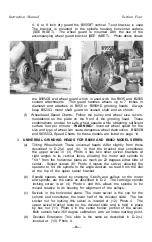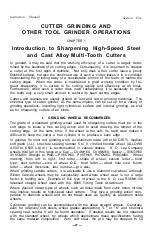
Instruction Manual
Section Five
The same relief angles are used for the face edges which, for rough milling,
should have a land about
⅜
inch wide, with the remaining portion of the
edge ground off at an angle of about 3 degrees toward the center of the
cutter, Finish milling is a thin shearing operation, and for best results, the
face of the cutter should be ground off at an angle of 1 degree to 2 de
grees to give it a slight lead into the work. The corners of the blades are
usually ground at 45 degrees bevel by swivelling the workhead or table, and
are left
1
/
16
inch to
⅛
inch wide.
After grinding, the cutter should be carefully checked on the face with a
dial indicator If the cutter has been properly ground, taking light finish
ing cuts of not more than one half thousandth inch per pass, tooth height
should be uniform.
5
END MILLS
(SEE PAGE 38 FOR ILLUSTRATION AND DESCRIPTION OF
A SPECIFIC SET-UP. SEE CHAPTER 14, PART V, PAGE 92 FOR DES
CRIPTION OF END MILL GRINDING WITH AN AIR-BEARING
WORKHEAD.)
End mills with shanks are supported in the universal workhead or in the
combination attachment, and are ground with the same spiral action as
described for plain milling cutters. If the end mill is the shell type, it
must first be mounted on a suitable arbor In sharpening the end teeth,
the workhead is usually swivelled horizontally about one-half degree from
the zero line so as to grind the teeth slightly low in the center of the mill
and thus prevent dragging. The workhead is then swivelled in the vertical
plane to give the desired relief (OR THE WHEELHEAD IS TILTED).
6.
ANGULAR CUTTERS
(SEE PAGE 42 FOR ILLUSTRATION AND DES
CRIPTION OF A SPECIFIC SET-UP.)
An angular cutter may be considered as made up of a number of plain
milling cutters of different diameters. When any cutter with a cup wheel
is ground on a conventional tool and cutter grinder, the relief angle is de
termined from the diameter of the cutter. It follows that this method
would lead to difficulties when applied to angular cutters because of the
variation in the diameter of the cutter along the cutting edge. For this
reason, the O.D. of a saucer wheel is commonly used.
On a tilthead cutter grinder, a cup wheel can be used without need of
"trial and error" tactics, and the relief angle is constant for the full tooth
length
On all non-tilthead grinders, the cutter is mounted on an arbor and sup
ported in a universal workhead, which is then swiveled to the angle of the
cutter. It may also be mounted between centers on an arbor, with table
swivelled. The toothrest is fastened to the swivel table or Wheelhead and
adjusted against the tooth to be ground, on center with the cutter. The
Wheelhead is then raised or lowered (OR MICROMETER ADJUSTED) to
give the desired relief, The cutter is held against the toothrest by hand as
it is traversed against the wheel edge. Chapter 7 of Section Five discusses
the set-up when using a saucer wheel to generate a constant clearance
angle.
7
METAL CUTTING SAWS
(SEE PAGE 84 FOR ILLUSTRATION AND
DESCRIPTION OF A SPECIFIC SET-UP.)
Small saws are ground in essentially the same manner as milling cutters —
usually with a 5 degree relief angle. On very small saws, the angle may
- 2 8 —
















































